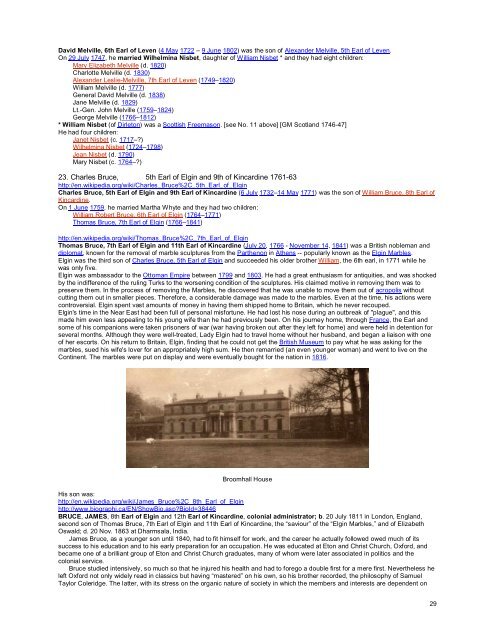Grand Masters of Scotland - Onondaga and Oswego Masonic ...
Grand Masters of Scotland - Onondaga and Oswego Masonic ...
Grand Masters of Scotland - Onondaga and Oswego Masonic ...
Create successful ePaper yourself
Turn your PDF publications into a flip-book with our unique Google optimized e-Paper software.
David Melville, 6th Earl <strong>of</strong> Leven (4 May 1722 – 9 June 1802) was the son <strong>of</strong> Alex<strong>and</strong>er Melville, 5th Earl <strong>of</strong> Leven.<br />
On 29 July 1747, he married Wilhelmina Nisbet, daughter <strong>of</strong> William Nisbet * <strong>and</strong> they had eight children:<br />
Mary Elizabeth Melville (d. 1820)<br />
Charlotte Melville (d. 1830)<br />
Alex<strong>and</strong>er Leslie-Melville, 7th Earl <strong>of</strong> Leven (1749–1820)<br />
William Melville (d. 1777)<br />
General David Melville (d. 1838)<br />
Jane Melville (d. 1829)<br />
Lt.-Gen. John Melville (1759–1824)<br />
George Melville (1766–1812)<br />
* William Nisbet (<strong>of</strong> Dirleton) was a Scottish Freemason. [see No. 11 above] [GM <strong>Scotl<strong>and</strong></strong> 1746-47]<br />
He had four children:<br />
Janet Nisbet (c. 1717–?)<br />
Wilhelmina Nisbet (1724–1798)<br />
Jean Nisbet (d. 1790)<br />
Mary Nisbet (c. 1764–?)<br />
23. Charles Bruce, 5th Earl <strong>of</strong> Elgin <strong>and</strong> 9th <strong>of</strong> Kincardine 1761-63<br />
http://en.wikipedia.org/wiki/Charles_Bruce%2C_5th_Earl_<strong>of</strong>_Elgin<br />
Charles Bruce, 5th Earl <strong>of</strong> Elgin <strong>and</strong> 9th Earl <strong>of</strong> Kincardine (6 July 1732–14 May 1771) was the son <strong>of</strong> William Bruce, 8th Earl <strong>of</strong><br />
Kincardine.<br />
On 1 June 1759, he married Martha Whyte <strong>and</strong> they had two children:<br />
William Robert Bruce, 6th Earl <strong>of</strong> Elgin (1764–1771)<br />
Thomas Bruce, 7th Earl <strong>of</strong> Elgin (1766–1841)<br />
http://en.wikipedia.org/wiki/Thomas_Bruce%2C_7th_Earl_<strong>of</strong>_Elgin<br />
Thomas Bruce, 7th Earl <strong>of</strong> Elgin <strong>and</strong> 11th Earl <strong>of</strong> Kincardine (July 20, 1766 - November 14, 1841) was a British nobleman <strong>and</strong><br />
diplomat, known for the removal <strong>of</strong> marble sculptures from the Parthenon in Athens -- popularly known as the Elgin Marbles.<br />
Elgin was the third son <strong>of</strong> Charles Bruce, 5th Earl <strong>of</strong> Elgin <strong>and</strong> succeeded his older brother William, the 6th earl, in 1771 while he<br />
was only five.<br />
Elgin was ambassador to the Ottoman Empire between 1799 <strong>and</strong> 1803. He had a great enthusiasm for antiquities, <strong>and</strong> was shocked<br />
by the indifference <strong>of</strong> the ruling Turks to the worsening condition <strong>of</strong> the sculptures. His claimed motive in removing them was to<br />
preserve them. In the process <strong>of</strong> removing the Marbles, he discovered that he was unable to move them out <strong>of</strong> acropolis without<br />
cutting them out in smaller pieces. Therefore, a considerable damage was made to the marbles. Even at the time, his actions were<br />
controversial. Elgin spent vast amounts <strong>of</strong> money in having them shipped home to Britain, which he never recouped.<br />
Elgin's time in the Near East had been full <strong>of</strong> personal misfortune. He had lost his nose during an outbreak <strong>of</strong> "plague", <strong>and</strong> this<br />
made him even less appealing to his young wife than he had previously been. On his journey home, through France, the Earl <strong>and</strong><br />
some <strong>of</strong> his companions were taken prisoners <strong>of</strong> war (war having broken out after they left for home) <strong>and</strong> were held in detention for<br />
several months. Although they were well-treated, Lady Elgin had to travel home without her husb<strong>and</strong>, <strong>and</strong> began a liaison with one<br />
<strong>of</strong> her escorts. On his return to Britain, Elgin, finding that he could not get the British Museum to pay what he was asking for the<br />
marbles, sued his wife's lover for an appropriately high sum. He then remarried (an even younger woman) <strong>and</strong> went to live on the<br />
Continent. The marbles were put on display <strong>and</strong> were eventually bought for the nation in 1816.<br />
Broomhall House<br />
His son was:<br />
http://en.wikipedia.org/wiki/James_Bruce%2C_8th_Earl_<strong>of</strong>_Elgin<br />
http://www.biographi.ca/EN/ShowBio.asp?BioId=38446<br />
BRUCE, JAMES, 8th Earl <strong>of</strong> Elgin <strong>and</strong> 12th Earl <strong>of</strong> Kincardine, colonial administrator; b. 20 July 1811 in London, Engl<strong>and</strong>,<br />
second son <strong>of</strong> Thomas Bruce, 7th Earl <strong>of</strong> Elgin <strong>and</strong> 11th Earl <strong>of</strong> Kincardine, the “saviour” <strong>of</strong> the “Elgin Marbles,” <strong>and</strong> <strong>of</strong> Elizabeth<br />
Oswald; d. 20 Nov. 1863 at Dharmsala, India.<br />
James Bruce, as a younger son until 1840, had to fit himself for work, <strong>and</strong> the career he actually followed owed much <strong>of</strong> its<br />
success to his education <strong>and</strong> to his early preparation for an occupation. He was educated at Eton <strong>and</strong> Christ Church, Oxford, <strong>and</strong><br />
became one <strong>of</strong> a brilliant group <strong>of</strong> Eton <strong>and</strong> Christ Church graduates, many <strong>of</strong> whom were later associated in politics <strong>and</strong> the<br />
colonial service.<br />
Bruce studied intensively, so much so that he injured his health <strong>and</strong> had to forego a double first for a mere first. Nevertheless he<br />
left Oxford not only widely read in classics but having “mastered” on his own, so his brother recorded, the philosophy <strong>of</strong> Samuel<br />
Taylor Coleridge. The latter, with its stress on the organic nature <strong>of</strong> society in which the members <strong>and</strong> interests are dependent on<br />
29







![Richard [Nicholls] Harison / Harrison - Onondaga and Oswego ...](https://img.yumpu.com/24950065/1/190x245/richard-nicholls-harison-harrison-onondaga-and-oswego-.jpg?quality=85)

![Richard [Nicholls] Harison / Harrison - Onondaga and Oswego ...](https://img.yumpu.com/24950063/1/190x245/richard-nicholls-harison-harrison-onondaga-and-oswego-.jpg?quality=85)







